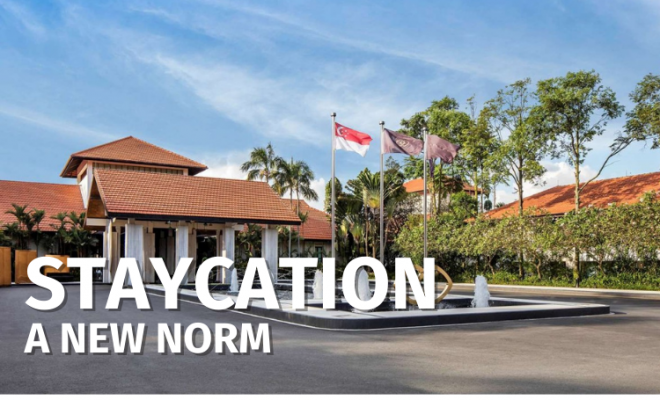“Staycations”: A New Norm for Singapore’s Hotels and Guests

There is no doubt that the COVID-19 situation that Singapore and the world is facing is having a dampening effect on the hospitality industry. International travel was slowing down from March 2020 up until April when Singapore went into its “Circuit-Breaker” to attempt to “flatten-the-curve”. The new and highly enforced measures took caused a drastic impact on the day-to-day operations of restaurants, as well as closing hotels from accepting new arrivals, including those from Singapore.
While the Singapore hospitality industry was experiencing these challenges and trying to adapt to a whole new climate of serving customers, so were the customers themselves. Singapore is a nation known for its food and for the first time in a generation, its population was not able to go out to eat food.
After the two-month circuit-breaker period, people were excited for the prospects of Phase two, with the lifting of restrictions enabling them to experience new norms – eat out once again; socialise with new measures and be able to experience a staycation away from home.
A major benefit of being situated on the island city-state is the quick and often low cost flights to the beautiful beaches, bustling cities and vast countryside of our neighbouring countries in the region. Southeast Asia is home to some of the most popular and sought after holiday destinations and for those living here who are from Europe or further afield, the trips can be made at a fraction of the cost as from their home country. This is one reason as to why the hotel industry here at home has adapted in recent times to appeal to residents of Singapore to take a weekend of luxury within 30 kilometres of their own home.
Channel News Asia (CNA), announced on 15th July 2020, that 35 out of 100 hotels had been approved by the Singapore Tourism Board to reopen in Phase two for Staycations and for use of their swimming, spa and other leisure facilities. An example is the Sofitel Singapore Sentosa Resort and Spa, whom CNA reported had received up to one thousand enquiries per day since the announcement of its reopening on 10th July. Despite this, they, like many Singapore hotels, have capped their occupancy at 50% to ensure safety for guests and staff alike. Another step being taken by the Sentosa hotel is that they also leave rooms vacant for a minimum period of 24hours in between guests. Such measures will inevitably slow down their income of revenue for hotels that often run on high occupancy but is now a necessary measure to operate under a new set of circumstances across the board.
Another popular hotel in Singapore that is open now for staycations is Marina Bay Sands and they too are doing things differently these days. According to their own website, they are practicing safe distancing in their hotel rooms, restaurants and cafes where groups cannot exceed five people. Crowd control and temperature screening are mandatory for staff and guests: members of staff who can work from home will do so and any guest, visitor or employee with a temperature reading higher than 38 degrees Celsius will be “politely turned away”. Marina Bay Sands is also championing what they have called a “Contactless Journey”. In an effort to reduce interpersonal exposure, guests will experience a new culture involving minimal contact during payment, luggage delivery and the delivery of other services throughout the hotel.
Only having residents of Singapore as guests within hotels and patrons to their dining establishments helps both the Singapore authorities and hotels with contact tracing, crowd management and ensuring safety for both staff and guests. A lack of tourists ensures that all that are entering establishments are in possession of a Singapore Identity Card that can be used, alongside new QR Code technology, for tracking purposes in case of possible exposures to the virus. The records of guests must be maintained for a minimum period of 28 days to assist in contract tracing efforts too.
The future of international travel to and from Singapore is still uncertain. To many people, spending S$300 or more to stay in a hotel room ten minutes away from home would be an absurd idea under the current circumstances. But the challenges the industry is facing given the COVID-19 situation are going to remain for the foreseeable future and “Staycations” are the latest catch, as can be seen at hotels such as Hotel Yan in Jalan Besar which is now fully booked for weeks ahead. Discounts of 50% or more with spa packages, restaurant credit and other perks are being offered across hotels in Singapore, but one of the biggest questions at the moment surely must be: “are we willing to pay more than a return trip to Bali just for a staycation that is a ten-minute drive away from home?”
References and Resources
https://www.mylifeelsewhere.com/country-size-comparison/united-states/singapore
https://www.marinabaysands.com/company-information/sands-clean-and-safe.html
Kit, T C, Singapore hotels look to woo staycationers with promotions, COVID-19 safety measures, CNA
Image 1: My own Image
Image 2: From Sofitel Website: Front Entrance of Sofitel Sentosa
Image 3: From Straits Times Website: Marina Bay Sands customers and staff wear facemasks
Image 4: From Straits Times Website: Marina Bay Sands lit up at night in support of Singapore during the COVID-19 pandemic.
Image 5 (main/title image) From Human Resources Online
This Article is contributed by Josh Flynn, a student at the School of Tourism & Hospitality.










